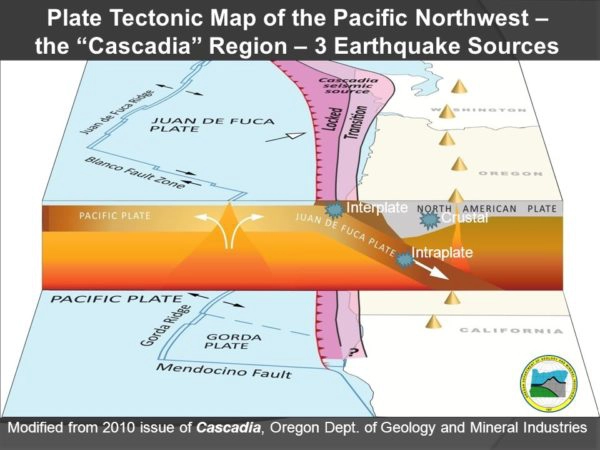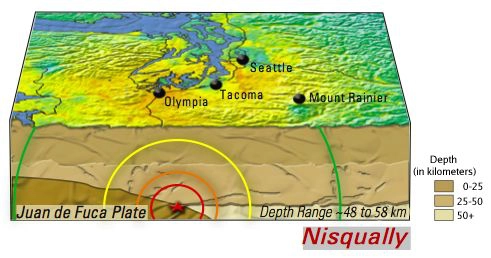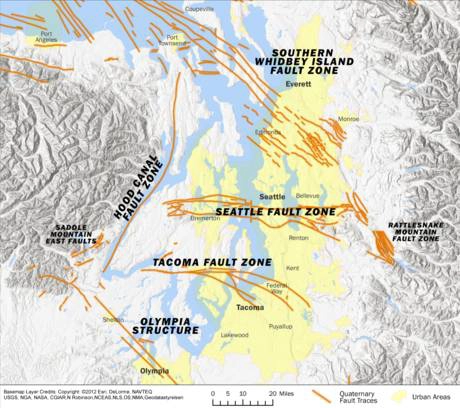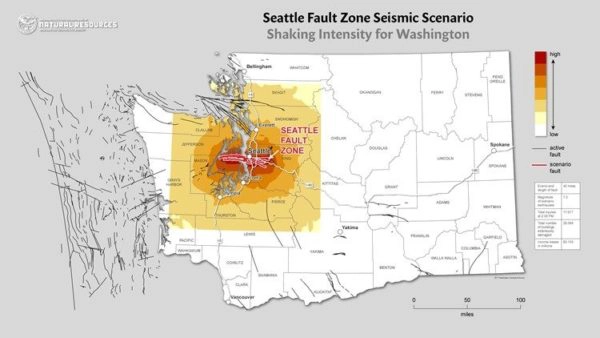Education
What is an Earthquake?
Earthquakes are common occurrences due to plate tectonics; the slow movement of rock landmasses that are constantly grinding against one another, creating stress. Eventually, the stress builds up at points of rock weakness and result in a sudden release of stored energy, which create seismic waves and results in an earthquake.
We live in a seismically active region that is often forgotten and overlooked due to the lack of frequency and destruction our region has experienced. The Pacific Coast is known for its earthquakes and is considered the most seismically active region in North America. Though, we experience frequent earthquakes, most cannot be felt due to their magnitude and depth of occurrence and go unnoticed. The Pacific Northwest is compressed by geological forces that are unpredictable, and formed from it’s very active, and occasionally violent, natural environment.
The Ring of Fire
The Ring of Fire is a 25,000 mile long chain of volcanoes and earthquakes around the perimeter of the Pacific ocean coastlines. The Ring of Fire encapsulates several tectonic plates that are constantly moving inches per year due to the heating and cooling of these plates. Where these plates meet results in a collision zone of volcanic eruptions, earthquakes and oceanic trenches. These plates regularly skid past, colliding into, and move above or below each other, resulting in fault lines.
About 90% of all the worlds earthquakes and more than 75% of all the volcanic eruptions occur within the Ring of Fire. The largest earthquakes in our world’s history are known as subduction zone earthquakes. Most of the largest earthquakes in recent history have occurred within the Ring of Fire. Most prominently in the past decade, the 2010 Chile earthquake (8.8 magnitude) resulting in 525 deaths and the 2011 Japanese Tohoku earthquake (9.0 magnitude) resulting in 15,895 deaths and 2,539 still missing.

Earthquakes in the Pacific Northwest
The Pacific Northwest is host to three different types of earthquakes: subduction zone earthquakes; deep slab earthquakes; and shallow crustal earthquakes. Click the photo on the left for an expanded view of a detailed map of the three different types of earthquakes in our region.

In a 2015 article, entitled The Really Big One, Katheryn Shultz of the New Yorker, discusses the Cascadia subduction zone, which runs over 600 miles north to south, from northern Vancouver Island to Cape Mendocino in northern California. Her article has made many in our region aware of the extent to which we are in a seismically active zone, and led to a significant increase in the demand for seismic retrofit work.

The last Cascadia subduction zone earthquake of a significant magnitude occurred in 1700. Our history has shown that these earthquakes occur every 300-600 years.
Explore more news and resources about earthquake.

Most of us experienced the 2001 Nisqually earthquake, and very few rode through the 1965 and 1949 earthquakes without serious injury or damage. Most people do not realize that these earthquakes we experienced were relatively small or moderate in comparison to the more catastrophic events our region could be hit with. Washingtonian’s who experienced any of the three deep slab earthquakes, experienced the mildest of the three that could occur at any time in our region of the Pacific Northwest.
These types of earthquakes are the most frequent in our region and typically occur every 30-50 years.
The constant load and release of energy from subduction zone earthquakes, occurring every 300-600 years for the last 16 million years, has created a permanent deformation of the North American plate. There are several fractures within the North American plate, just below the surface of the Puget Sound and cities and towns, to include South Whidbey and Tacoma. Seattle has the misfortune of sitting directly on top of one such fracture.
The 43-mile Seattle fault runs west from the Hood Canal through the Puget Sound and south Seattle, parallel



We would definitely hire this company again. They had good communication; were prompt; respectful of our property; and completed the work in less time than expected. In general, they did a great job.